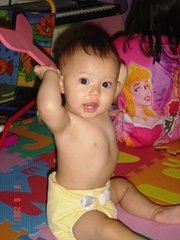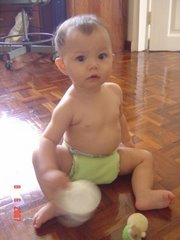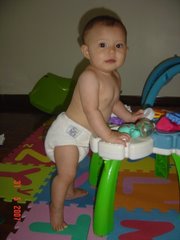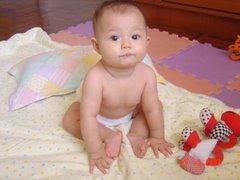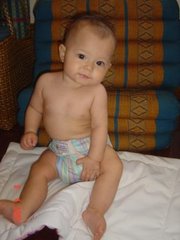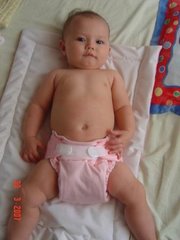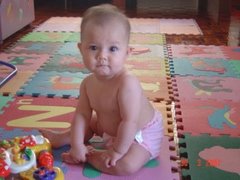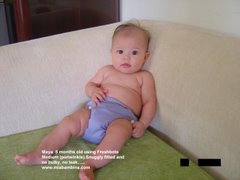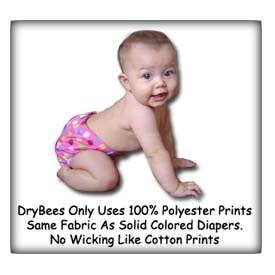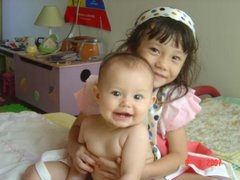I just thought of post this again, this is the same like the one in my e-store. But it is better ! Thanks to Kittycat. :)
My Story
We may all have heard that cloth diapers are healthier for your baby’s bottom, as it means less diaper rash. These days, disposable diapers seem to be a good option for babies as they come with breathable, cotton, fabric-like features. Why then would modern moms like us need to use cloth diapers?
Before my second baby was born, I could never imagine that I will use cloth diapers. With my first daughter, Indiana, I was all about breastfeeding and baby-wearing but had never tried cloth diapers. At that time, I had in my mind that cloth diapers were old-fashioned and troublesome; only old fashioned moms would use them. Who needs a cloth diaper and pins today?
When Maya was born, I was still fully dedicated to breastfeeding and baby- wearing. Among the baby gifts was a pack of flat cotton gauze diapers from a friend. I was like, “Ok, I will try them.” But I didn’t have a clue how to. I turned to the internet and found www.diaperhyena.com, where I learnt how to fold a flat diaper, use a pin and a diaper cover I bought at a local store.
I was so stunned by the choices in cloth diapers today. There are pre-folds, fitted, AIOs (all in one), pocket diapers, one-sized diapers…And then, there are inserts, boosters, soakers, microfiber/microterry, hemp, fleece and so on. That had me wondering, "Are they still talking about the same topic here? Cloth diapers?” YES! Wow, I didn’t know that the cloth diaper has evolved so much.
Next, I searched on the internet, looking at what shops had to offer, the type of products and brands available. I tried them out with my baby and I loved them. I LOVE cloth diapers! I won’t turn back to disposables anymore.
Here’s why I use cloth diapers and love them:
1. CHEAPER than disposables
Is this true? YES. Initially, the cloth diaper seems to be expensive. When I saw how much a cloth diaper cost, I was stunned. For around USD 15 to 20 each, I would need at least 15 pieces or more. I’m going to spend around USD 100 -150 on cloth diapers? Isn’t it supposed to be cheaper?
After I did some math (which I normally hate LOL), they turned out to be CHEAPER, MUCH CHEAPER. Here is the break down of my calculations:
A newborn baby will use up to 12 diapers a day.
Older babies will need around 8 diapers a day until they are ready for potty training.
On average, that will be about 8 diapers per day. That’s around 2,900 diapers per year.
The average potty trained age is 3 years. 3 x 2,900 diapers = 8,700 diapers in total until the child is potty trained.
In Malaysia, the average cost of a normal brand diaper is RM 0.50.
Thus, the total cost of using disposable diapers will be 8,700 x RM 0.50 = RM 4,350.
This doesn’t include the wipes and the diaper rash cream!
If you use cloth diapers you will need around:
12 small,
12 medium and/or
8 large sizes.
The average price for a cloth diaper is around RM 65-75.
That’s 32 x RM 70 = RM 2,240.00
You have just saved over RM 2,000!
WAIT, that's only for one child. If you use it for your other children, you will save more of course. Furthermore, studies show that babies in cloth diapers reach the potty training stage much faster than babies using disposable diapers. Sounds good? Keep reading...
2. I have always wanted to provide the healthier choice to my children, which I think is every mother’s intention. That’s why I choose breastfeeding. It builds their immune system and gives them the best nutrition from the first day. I also try to give only all natural and homemade foods, if possible, to avoid any colorings and preservatives. I believe a lot of mothers do that too.
What most of us don’t realize is that disposable diapers are NOT the healthiest choice. They contain chemicals, like Dioxin that causes cancers and other diseases. Dioxin is a toxic by-product from the paper-bleaching process and is listed by the US Environmental Protection Agency as the most toxic of all cancer-linked chemicals.
They also contain Tributyl-tin (TBT) – a toxic pollutant known to cause hormonal problems in humans and animals. The super absorbent crystals (which is the same ingredient that was removed from tampons) known as Polyacrylate cause toxic shock syndrome.
Disposable diapers are also linked to childhood respiratory problems like asthma. Research also shows that scrotal temperature is increased in boys wearing disposable diapers and may adversely affect fertility later in life. (read more on why use cloth diapers)
Feel free to check out more information on the internet for your reference. I’m thinking, “If I want to give a healthy start for my children, why would I use disposable diapers?”
3. Disposable diapers make up a lot of the garbage found on our planet. It’s a serious issue now. If we don’t take a small step now, who knows what will happen to our next generation?
Did you know that over 300 pounds of wood, 50 pounds of petroleum feedstocks and 20 pounds of chlorine are used to produce disposable diapers for ONE baby each year?
Disposable diapers take 200-500 years to degrade in landfills. There are new bio-degradeable diapers but they also take 100 years to degrade in a landfill.
How are our children going to live in the more polluted planet?
While disposable diapers produce 7 times more solid waste when discarded and 3 times more waste in the manufacturing process, cloth diapers can be washed and reused 80-200 times, and then used as rags. This saves about 10,000 disposable diapers per baby.
4. Cloth diaper nowadays are fun and fashionable. Be a trend setter. Make your baby’s bum the cutest bum on the block!
But is it a lot of work to use cloth diapers? Not a lot but yeah, it is a bit more work. It’s just another piece of laundry to wash. And it’s not hard to wash. Many moms worry about the smell, the stains and more laundry to do. This is not exactly true. You don’t need to soak the diapers overnight to remove stains, and they don’t smell that bad either! Read more at facts and fiction.
After I have tried and fallen in love with cloth diapers, I know I must spread the word about the goodness of cloth diapering. I am doing this in Asia particularly because in the US, Australia and Europe, the cloth diaper is making a BIG comeback. That’s why I choose to start my online shop.
The first time my friends heard that I’m going to sell cloth diapers, they all thought I was crazy. “What, you’re going to sell cloth diapers? The ones with the plastic or rubber pants, which needs a string and a pin?” Little did he know ;-)
I’m still doing in anyway LOL and many people still haven’t realized or know about modern cloth diapers. Luckily, I met a few ladies online and some owners of online shops too. We discussed, chatted and talked about cloth diapers. We hope we can make a small difference in what people think about cloth diapers. And I hope more and more mums become aware of the goodness of cloth diapers.
Invest in your children’s health and environment. Happy cloth diapering!
Sandra Rocco
 Bamboo fabric is a natural textile made from the pulp of the bamboo grass. Bamboo fabric has been growing in popularity because it has many unique properties and is more sustainable than most textile fibers. Bamboo fabric is light and strong, has excellent wicking properties, and is to some extent antibacterial. The use of bamboo fiber for clothing was a 20th century development, pioneered by several Chinese Bamboo fiber resembles cotton in its unspun form, a puffball of light, airy fibers. Many companies use extensive bleaching processes to turn bamboo fiber white, although companies producing organic bamboo fabric leave the bamboo fiber unbleached. To make bamboo fiber, bamboo is heavily pulped until it separates into thin component threads of fiber, which can be spun and dyed for weaving into cloth.
Bamboo fabric is a natural textile made from the pulp of the bamboo grass. Bamboo fabric has been growing in popularity because it has many unique properties and is more sustainable than most textile fibers. Bamboo fabric is light and strong, has excellent wicking properties, and is to some extent antibacterial. The use of bamboo fiber for clothing was a 20th century development, pioneered by several Chinese Bamboo fiber resembles cotton in its unspun form, a puffball of light, airy fibers. Many companies use extensive bleaching processes to turn bamboo fiber white, although companies producing organic bamboo fabric leave the bamboo fiber unbleached. To make bamboo fiber, bamboo is heavily pulped until it separates into thin component threads of fiber, which can be spun and dyed for weaving into cloth. 
















